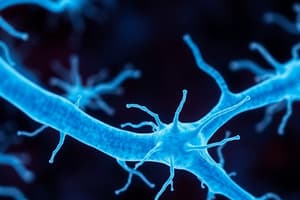Podcast
Questions and Answers
The spinal cord has 32 segments.
The spinal cord has 32 segments.
False (B)
Cerebrospinal fluid is produced in the spinal cord.
Cerebrospinal fluid is produced in the spinal cord.
False (B)
The autonomic nervous system is divided into three divisions.
The autonomic nervous system is divided into three divisions.
False (B)
The parasympathetic nervous system is responsible for the 'flight or fight' responses.
The parasympathetic nervous system is responsible for the 'flight or fight' responses.
The peripheral nervous system includes the brain and spinal cord.
The peripheral nervous system includes the brain and spinal cord.
The spinal cord is longer than the spinal column.
The spinal cord is longer than the spinal column.
The peripheral nervous system contains the brain and spinal cord.
The peripheral nervous system contains the brain and spinal cord.
Neurons are the structural and functional units of the circulatory system.
Neurons are the structural and functional units of the circulatory system.
All neurons have true dendrites.
All neurons have true dendrites.
Interneurons are located only in the peripheral nervous system.
Interneurons are located only in the peripheral nervous system.
Schwann cells are found on nerve fibers in the central nervous system.
Schwann cells are found on nerve fibers in the central nervous system.
Damage to nerve fibers in the peripheral nervous system is not reversible.
Damage to nerve fibers in the peripheral nervous system is not reversible.
A bundle of nerve fibers is called a nerve cell.
A bundle of nerve fibers is called a nerve cell.
Neuroglia are the nerve cells that conduct impulses.
Neuroglia are the nerve cells that conduct impulses.
The pia mater is the outermost membrane of the meninges.
The pia mater is the outermost membrane of the meninges.
The thalamus is the relay center for all sensory impulses including olfactory.
The thalamus is the relay center for all sensory impulses including olfactory.
The cerebellum coordinates involuntary patterns of movements only.
The cerebellum coordinates involuntary patterns of movements only.
Efferent nerves conduct impulses to the central nervous system.
Efferent nerves conduct impulses to the central nervous system.
Synapses are the gaps between two neurons.
Synapses are the gaps between two neurons.
The hypothalamus regulates only emotional expression and body temperature.
The hypothalamus regulates only emotional expression and body temperature.
The medulla oblongata is responsible for regulating visceral control.
The medulla oblongata is responsible for regulating visceral control.
The diencephalon refers to the brainstem and the cerebrum.
The diencephalon refers to the brainstem and the cerebrum.
Flashcards are hidden until you start studying
Study Notes
Nervous System
- The nervous system consists of two divisions: central nervous system (brain and spinal cord) and peripheral nervous system (network of nerves and neural tissues).
- Neurons are the nerve cells, the structural and functional units of the nervous system, conducting impulses that enable the body to interact with its internal and external environments.
Types of Neurons
- Motor neurons: have one axon and several dendrites, transmit signals to muscles and glands, and control body functions.
- Sensory neurons: do not have true dendrites, attached to sensory receptors, and transmit impulses to the central nervous system.
- Interneurons: located entirely within the central nervous system, intercept impulses from sensory neurons and transmit signals to motor neurons.
Nerve Fibers
- Schwann cells: only found on peripheral nerves, can regenerate.
- Myelin sheath: a fatty layer of insulation on some nerve fibers.
- Axon: transmits the message.
- Nerve fibers in the central nervous system do not have Schwann cells, making damage to those fibers irreversible.
- A bundle of nerve fibers is called a nerve.
Synapses
- Nerve impulses are transmitted via synapses, connecting dendrites and axons from one neuron to another.
Brain and Spinal Cord
- The brain and spinal cord are enclosed by three membranes: dura mater, arachnoid, and pia mater.
Parts of the Brain
- Cerebrum: governs all sensory and motor activity, including sensory perception, emotions, consciousness, memory, and voluntary movements.
- Cerebellum: coordinates voluntary and involuntary patterns of movements.
- Diencephalon: includes thalamus and hypothalamus.
- Thalamus: relay center for sensory impulses except olfactory (sense of smell) and motor areas of the cortex.
- Hypothalamus: regulates behavior, emotional expression, body temperature, and many metabolic activities.
- Brainstem: includes midbrain, pons, and medulla oblongata.
- Midbrain: controls visual reflexes and sense of hearing.
- Pons: plays a role in regulating visceral (internal organ) control.
- Medulla oblongata: connects the rest of the brain to the spinal cord, regulates breathing, swallowing, coughing, sneezing, vomiting, heartbeat, and blood pressure.
Spinal Cord
- The spinal cord has 31 segments, corresponding to the vertebrae.
- The spinal cord is shorter than the spinal column.
Cerebrospinal Fluid
- A colorless fluid produced in the ventricles of the brain, surrounding the brain and spinal cord, and cushioning them from shocks that could cause injury.
Peripheral Nervous System
- The network of nerves branching out throughout the body from the brain and spinal cord.
- Autonomic nervous system: a part of the peripheral nervous system, controlling involuntary bodily functions such as sweating, gland secretions, blood pressure, and the heart.
- Autonomic nervous system is divided into sympathetic and parasympathetic divisions.
- Sympathetic nervous system: responsible for the 'flight or fight' responses, increasing alertness, metabolic rate, respiration, blood pressure, heart rate, and sweating, and decreasing digestive and urinary function.
- Parasympathetic nervous system: counteracts the responses of the sympathetic system, restoring homeostasis.
Studying That Suits You
Use AI to generate personalized quizzes and flashcards to suit your learning preferences.




